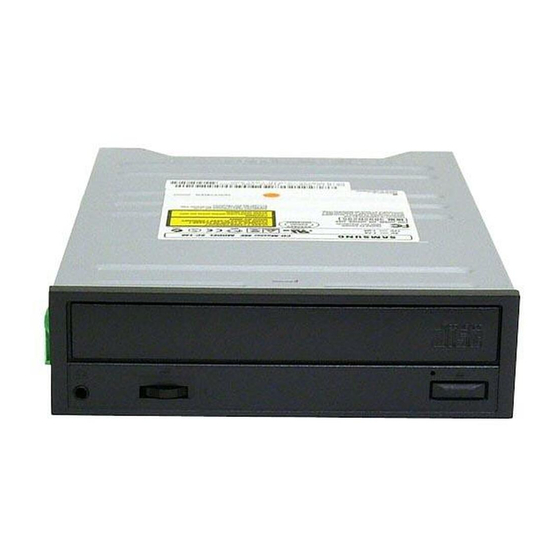
Table of Contents
Advertisement
Quick Links
Index
Main Page
Safety Precautions
Notational
Installation
While Operating
Other
Introduction
Front
Rear
Setup
Installing the CD-ROM Drive
Connecting the Cables
Installing the Device Driver
Setting Up the Device Driver
Using the Drive
Using the CD-ROM Drive
Storing and Cleaning Your Discs
Upgrading the Firmware Flash Memory
System Requirements
Troubleshooting
Solving Technical Problems
Specifications
Advertisement
Table of Contents

Summary of Contents for Samsung SC-148A
- Page 1 Introduction Front Rear Setup Installing the CD-ROM Drive Connecting the Cables Installing the Device Driver Setting Up the Device Driver Using the Drive Using the CD-ROM Drive Storing and Cleaning Your Discs Upgrading the Firmware Flash Memory System Requirements Troubleshooting...
-
Page 2: Safety Precautions
Always make sure that the disc does not have a crack before use. If the disc has a crack (especially around the center hole), it is recommended to make a copy immediately and use the copy instead. -
Page 3: Installation
Installation Installation Place the drive on a level surface. - Failure to do so may cause the device to fall onto a hard surface, resulting in damage or malfunction. Do not place the drive in direct sunlight. Avoid low- or high-temperature environments. -
Page 4: While Operating
- Do not insert a pin into the emergency opening while in operation. Do not use cracked, distorted or damaged discs. - In particular, a disc with a crack on the inner tracks may break while in use. - Page 5 Never allow food particles or foreign substances to enter the drive casing. To protect against the risk of fire, do ot spill such liquids as alcohol and benzene on the drive. Do not disassemble, attempt to repair or modify the device without express approval as directed in the manual.
- Page 6 The compartment opens and closes automatically when you press the Eject button. 4. Emergency eject hole If the compartment does not open when you press the Eject button, power off the computer, insert a pin or unfolded paper clip in the hole and push firmlhy) 5.
- Page 7 3. Master/slave select terminal Usually, this is a pre-set configuration as illustrated below. Verify that the setting is as illustrated. If it is not, simply remove the jumper and place it in the correct position. 4. Interface terminal This input/output interface terminal is used to connect the 40-pin flat cable from the IDE interface to the CD-ROM drive.
-
Page 8: Installing The Cd-Rom Drive
Make sure that the PC is powered off and disconnected from any power source. If necessary, attach a horizontal bracket to both sides of the drive. Remove the cover from a free expansion slot and install the CD-ROM drive, as shown in the illustration. - Page 9 Setup Connecting the power cable The 4-pin power cable from the internal power unit of your computer must be connected to the power terminal on the rear of the CD-ROM drive. A - Cut Side Note: An improperly connected power cable may cause trouble. Check the direction of the power connector and the incline side of the CD-ROM drive before connecting.
- Page 10 If the jumper is connected to SL (Slave), it will work in the Slave mode. If the jumper is connected to CS (CSEL), you can control the device by using the host interface signal CSEL. (In general, connection to MA is recommended.)
- Page 11 Installing the Device Driver No additional device driver is needed for Windows 95/98/2000/ME/XP/NT4.0, as the default Windows device driver is used. You can check that the CD-ROM drive has been correctly detected by Windows. To do so, proceed as follows.
-
Page 12: Using The Cd-Rom Drive
Do not touch the surface of a disc; hold it by the edges. To clean a disc, polish lightly from the inside of the disc to the outside with a soft cotton cloth. Do not leave the disc compartment open when you are not using it. -
Page 13: Upgrading The Firmware Flash Memory
The product firmware can be upgraded by downloading the updated file from the following Web site: http://samsung-ODD.com http://samsung.com System Requirements Before you install the CD-ROM drive, we strongly recommend that you check that your setup meets the system requirements listed below. Item Description... -
Page 14: Troubleshooting
The CD-ROM drive is not detected after it is connected to You must therefore connect the CD-ROM drive to the IDE port on the PC mother board, rather than to the sound card, or install an IDE a sound card. compatible sound card. -
Page 15: Specifications
Specifications SAMSUNG continually strives to improve its products. Both the design specifications and these user instructions are thus subject to change without notice. Technical Specifications ITEM Model Name SC-148A Disc CD-DA, CD-ROM Mode-1, CD-ROM XA Mode-2 Form-1, Form-2, Disc types supported in...











